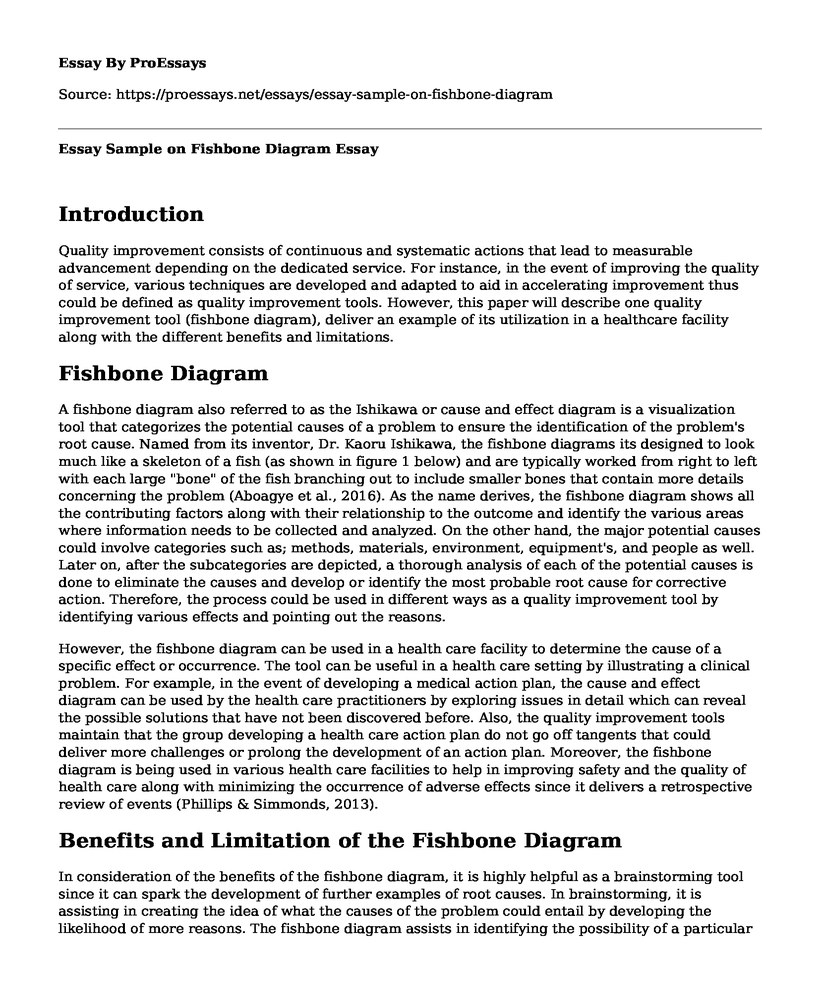Introduction
Quality improvement consists of continuous and systematic actions that lead to measurable advancement depending on the dedicated service. For instance, in the event of improving the quality of service, various techniques are developed and adapted to aid in accelerating improvement thus could be defined as quality improvement tools. However, this paper will describe one quality improvement tool (fishbone diagram), deliver an example of its utilization in a healthcare facility along with the different benefits and limitations.
Fishbone Diagram
A fishbone diagram also referred to as the Ishikawa or cause and effect diagram is a visualization tool that categorizes the potential causes of a problem to ensure the identification of the problem's root cause. Named from its inventor, Dr. Kaoru Ishikawa, the fishbone diagrams its designed to look much like a skeleton of a fish (as shown in figure 1 below) and are typically worked from right to left with each large "bone" of the fish branching out to include smaller bones that contain more details concerning the problem (Aboagye et al., 2016). As the name derives, the fishbone diagram shows all the contributing factors along with their relationship to the outcome and identify the various areas where information needs to be collected and analyzed. On the other hand, the major potential causes could involve categories such as; methods, materials, environment, equipment's, and people as well. Later on, after the subcategories are depicted, a thorough analysis of each of the potential causes is done to eliminate the causes and develop or identify the most probable root cause for corrective action. Therefore, the process could be used in different ways as a quality improvement tool by identifying various effects and pointing out the reasons.
However, the fishbone diagram can be used in a health care facility to determine the cause of a specific effect or occurrence. The tool can be useful in a health care setting by illustrating a clinical problem. For example, in the event of developing a medical action plan, the cause and effect diagram can be used by the health care practitioners by exploring issues in detail which can reveal the possible solutions that have not been discovered before. Also, the quality improvement tools maintain that the group developing a health care action plan do not go off tangents that could deliver more challenges or prolong the development of an action plan. Moreover, the fishbone diagram is being used in various health care facilities to help in improving safety and the quality of health care along with minimizing the occurrence of adverse effects since it delivers a retrospective review of events (Phillips & Simmonds, 2013).
Benefits and Limitation of the Fishbone Diagram
In consideration of the benefits of the fishbone diagram, it is highly helpful as a brainstorming tool since it can spark the development of further examples of root causes. In brainstorming, it is assisting in creating the idea of what the causes of the problem could entail by developing the likelihood of more reasons. The fishbone diagram assists in identifying the possibility of a particular root cause recurring over time which could lead to more or other effects. Additionally, the root and cause quality improvement tool allow one to see all the causes simultaneously which is essential in identifying the areas requiring improvement as well as helping the team understand that numerous causes contribute to the development of an effect.
Correspondingly, the fishbone diagram as a quality improvement tool has one major limitation. The users may tend to overlook the critical and complex interaction between causes leading to a particular effect; thus, it an effect caused by a combination of factors, it is difficult to utilize the tool in depicting and solving the problem.
References
Aboagye, R., Senesac, P., Morris, A., Johnston, J., & Cherala, S. (2016). Quality Improvement (QI) in Evaluation: Anatomy of a Fishbone (Diagram).
Phillips, J., & Simmonds, L. (2013). Using fishbone analysis to investigate problems. Nursing times, 109(15), 18-20.
Cite this page
Essay Sample on Fishbone Diagram. (2022, Nov 30). Retrieved from https://proessays.net/essays/essay-sample-on-fishbone-diagram
If you are the original author of this essay and no longer wish to have it published on the ProEssays website, please click below to request its removal:
- Tourette Syndrome Treatment Essay
- Ebola in the United States - Paper Example
- The Process of Budgeting in Nursing Paper Example
- Essay Example on My Journey to Become a Qualified Nurse: A Passionate Student's Story
- Review of the Institute of Medicine Report
- Essay on PMHNP: Diagnostic Assessment & Treatment for Psychiatric Disorders
- COVID-19: Showing Social Safety Net's Weaknesses & Low-Wage Worker Struggles - Essay Sample







